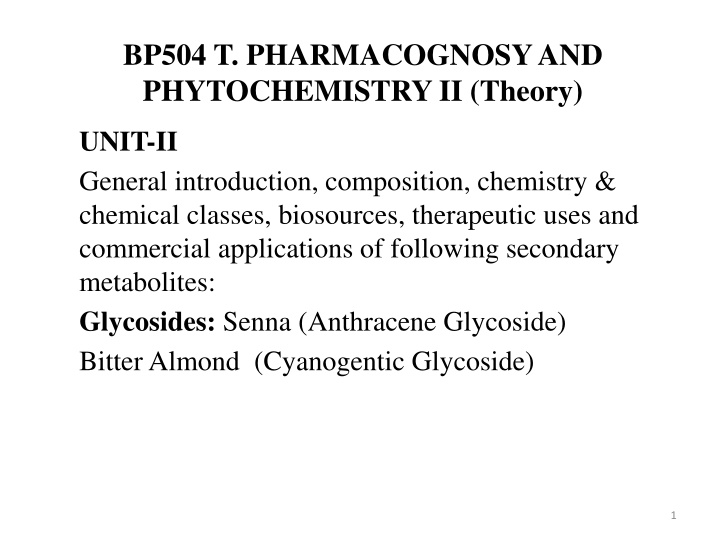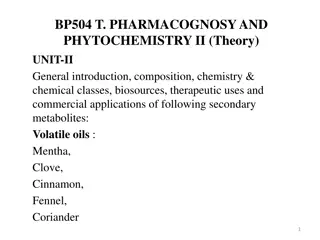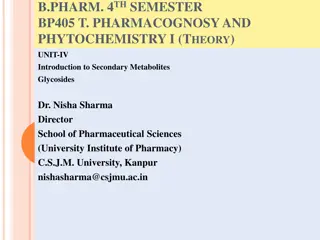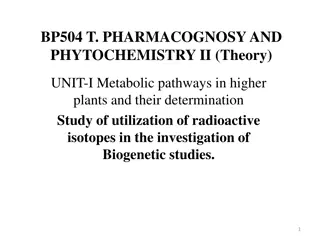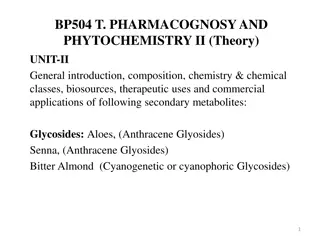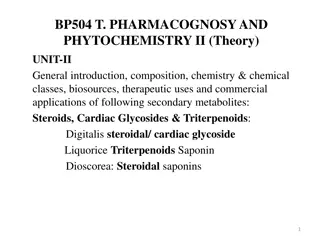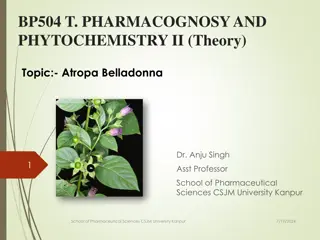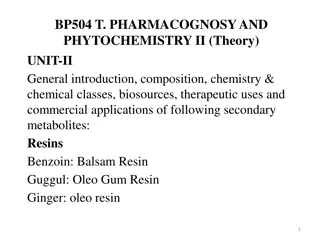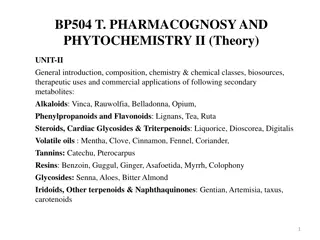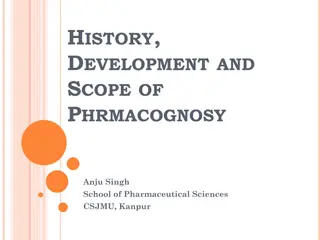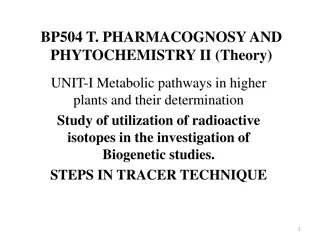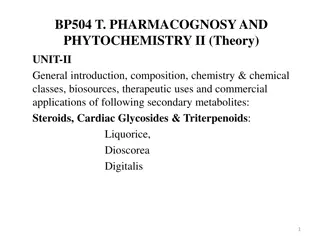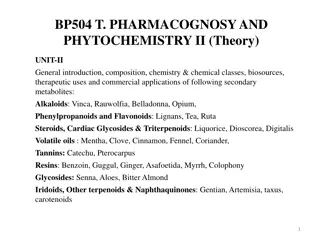Comparison of Alexandrian Senna and Indian Senna: Pharmacognosy and Phytochemistry Insights
Explore the pharmacognosy and phytochemistry of Alexandrian Senna and Indian Senna, detailing their collection, preparation, macroscopic and microscopic characteristics, chemical constituents, and potential adulterants. Learn about the therapeutic applications and commercial significance of these glycoside-rich plants commonly used in traditional medicine and pharmaceutical industries.
Download Presentation

Please find below an Image/Link to download the presentation.
The content on the website is provided AS IS for your information and personal use only. It may not be sold, licensed, or shared on other websites without obtaining consent from the author.If you encounter any issues during the download, it is possible that the publisher has removed the file from their server.
You are allowed to download the files provided on this website for personal or commercial use, subject to the condition that they are used lawfully. All files are the property of their respective owners.
The content on the website is provided AS IS for your information and personal use only. It may not be sold, licensed, or shared on other websites without obtaining consent from the author.
E N D
Presentation Transcript
BP504 T. PHARMACOGNOSY AND PHYTOCHEMISTRY II (Theory) UNIT-II General introduction, composition, chemistry & chemical classes, biosources, therapeutic uses and commercial applications of following secondary metabolites: Glycosides: Senna (Anthracene Glycoside) Bitter Almond (Cyanogentic Glycoside) 1
Alexandrian Senna Folia sennae Alexandrina, Cassia senna, Egyptian senna. B S : Dried leaflets of Cassia acutifolia family Leguminosae. G S Middle, upper Nile territories, tropical Africa specially Sudan. Collection and Preparation: obtained mainly from wild sources in Kordofon region of white Nile Province, & in Khartoum area. Collection of leaflets along with branches done when plants bear unripe fruits, & dried under sunlight. 2
Collection and Preparation Leaves-cleaned, graded into entire leaves, entire, broken leaves, siftings and pods. Process of separation carried out by sifting- 1st large stalks & pods separated, pods are manually plucked out. Material that passes through sieves contains entire leaves, broken leaves, heavier stalks & sand. Then mechanically tossed- entire, & broken leaves are cleared out from other part. Once again sifted, to separate mixed leaves, small fragments & very small leaflets. Entire leaves hand picked from mixed leaves, packed in mats or bales without pressing. 3
Macroscopic & Microscopic Characters Macro: Alexandrian senna resembles Tinnevelley senna except following characters. Alexandrian senna - 2-4 cm L, 7-12 mm wide, ovate- lanceolate shape. Margin entire, curled, base is asymmetrical, more pubescent, has thin brittle texture. pale greyish-green color Micro: Both Alexandrian senna & Tinnevelley senna very identical in microscopy. Various leaf constants : stomatal index, palisade ratio & vein-islet number. Alexandrian senna, 1) Stomatal index: 11.4 to 12.2 to 13.3 (For both surfaces) 2) Palisade ratio: 4.5 - 9.5 - 19 (upper surface) 3.5 - 7.0 - 14.5 (lower surface) 3) Vein-islet number: 25 - 29.5 4
Chemical Constituents All the chemical constituents of Alexandrian senna are same as that of Tinnevelley senna. The percentage of sennosides in leaves & pods is more (3 - 3.6%) as compared to Indian senna. Adulterants and Substitutes: found to be adulterated with Dog senna, Palthe senna, Bombay, Mecca or Arabian senna. 5
Indian Senna Senna leaf, Sennae folium, Senai-ki-patti, Tinnevelley senna, Cassia senna. B S: consists of dried leaflets of Cassia angustifolia or Cassia senna family Leguminosae. contains not less than 1.0% w/w of sennosides A and B calculated on dried basis. G S: in Tinnevelley, Madurai and Ramanathapuram districts of Tamil Nadu. Cudappa district of Andhra Pradesh, some extent collected from Kutch in Gujarat and Rajasthan. History: known to physicians from olden days , was included in Unani medicine. 6
Indian Senna About 26 species of genus Cassia reported to contain anthracene derivatives either in free form or glycosides. Among all Cassia angustifolia (Indian Senna), Cassia acutifolia (Alexandrian senna) official in pharmacopoeias, because of cathartic activity, also because available in large quantities. Other species with known cathartic activity are C. alata, C. fistula, C. obovata, C. podocarpa, C. sieberiana, C. sofora, C. dentata, C. javanica etc. 7
Cultivation, Collection and Preparation India 25000 hectares of land under cultivation Producing 22500 tons of leaves, 7500 tons of fruits/ annum Exported by ships from Tuticorin port Small shrub 1.5 m, compound paripinnate leaves, each leaf has 3 - 5 - 7 pairs of leaflets. Red loamy or coarse gravel soil , but grows on alluvial loamy soil Before sowing, land is ploughed twice, harrowed & levelled. First sowing- February-March, 2nd sowing in October November Sowing - done by broadcasting method. Earlier germination, seed surface is abraded or triturated with sand About 15 - 25 kg of seeds required/hectare of land & sown thinly. Plants- grown as a semi-irrigated or light-irrigated crop. Heavy irrigation, water logging, etc. are avoided. Plant cannot survive at very low temperatures. 8
Cultivation, Collection and Preparation Plants allowed - grow-5 months till growth of flower stalks Cutting given to flower stalks- further branching Leguminous plant, but nitrogenous fertilizers is beneficial because of lack of root nodules. After 2 - 3 months of sowing, harvesting of leaves-3 stages. 1st plucking-when leaflets thick, full-grown, greenish color After 1 month, 2nd plucking- done, last plucking after 4 6 W Plants are uprooted after 3rd plucking of leaves. Content of sennosides in leaves-maximum- when fully grown, goes on decreasing along with maturation of pods. Senna crop taken after rice crop on the same land in same season gives best yields, senna grown on dry land without proper irrigation gives poor results. 9
Cultivation, Collection and Preparation After collection, leaflets- dried under shade or indoor by spreading them in thin layers. Drying takes place within 7 - 10 days, leaves show yellowish green color. Leaves are tossed to separate pods, then packed into bales under hydraulic pressure. Pressing the leaves under hydraulic press produces transverse line on leaves, absent in Alexendrian senna leaves. During storage, protected from light. Generally does not lose potency atleast upto 5 years. 1,200 kg of leaves & pods are obtained in 1 hectare of irrigated land & 700 kg of drug from rain fed land. 10
Macroscopic Characters Color-Yellowish-green Odor-Slight, Taste - Mucilaginous, bitter, characteristic, Size-7to8 mm in width, 25-60 mm in length Shape - Leaves are lanceolate, entire, apex is acute with spine at the top. Bases of the leaflets are asymmetrical with transverse lines, more prominent on lower surface, while the trichomes are present on both the surfaces. 11
Microscopic Characters Isobilateral leaf, Epidermis-unicellular, conical, thick-walled warty trichomes, are slightly curved at bases, present on both surfaces. Rubiaceous or paracytic stomata present on epidermal surfaces. Palisade tissue present on both the sides, rectangular cells, enclose cluster-crystals of calcium oxalate. Spongy mesophyll & conducting tissues Patch of sclerenchyma towards upper epidermis & above xylem (also known as pericyclic fibres) present. Presence of cluster sheath & collenchyma are characteristics of the senna leaves. 12
Chemical Constituents Two anthraquinone glycosides- sennoside A & sennoside B (not less than 2.5%) accounts for purgative property. Tutin (1913) isolated rhein & aloe-emodin Stoll, his colleagues 1941 reported isolation of crystalline sennosides A & B. Sennosides A and B - stereoisomers . They are dimeric glycosides with rhein dianthrone as aglycone. Sennoside B the aglycone is in meso form, & in sennoside A, - dextrorotatory. They also differ in linkage of glucose to the aglycone fraction. Purgative activity of sennosides A and B accounts upto 40 60% activity of crude drug. 13
Chemical Constituents Sugar part of these glycosides- transporting function for the aglycone upto large intestine & protective action so that oxidation of aglycone to less active anthraquinone is prevented. Also contains other anthraquinone glycosides in small amounts, sennosides C & D, rhein 8-glucoside, rhein 8- diglucoside, aloe-emodin, 8-glucoside, aloe-emodin, anthrone diglucoside, rhein, kaempferol, aloe-emodin & isorhamnetin. Also contains phytosterol, mucilage, resin, myricyl alcohol, salicylic acid, chrysophanic acid & calcium oxalate. Senna contains 2 naphalene glycosides called Tinnevelley glycoside & 6 - hydroxy musizin glycoside. 14
Structures 15
Chemical Test Borntrager's test: For presence of anthraquinone in senna leaves. Drug + dil. H2SO4 + Boil, filter. To filtrate + benzene/ether / CHCl3 + shake well. The organic layer is separated +NH3 is added slowly. The ammonical layer shows pink to red color due to presence of anthraquinone glycosides. 16
USES As purgative in perpetual constipation. Anthraquinone glycosides of senna absorbed 1st in intestinal tract, then aglycone part is separated, excreted in colon. These excreted anthraquinone irritate, stimulate the colon hence movements are increased due to local action. The increase in peristalsis also causes reduction in the water absorption resulting in soft & bulky faeces. Griping effect caused by senna is due to resin or emodin content. To counteract the gripping effect, given with carminatives. Drug by parenteral mode is secreted in colon & causes therapeutic action. 17
Adulterants & Substitutes Tinnevelley senna : adulterated with Dog senna (C. obovata), Palthe senna (C. auriculata) & Mumbai, Mecca & Arabian senna mild variety of C. angustifolia from Arabia. Dog senna-leaves obovate shape,with tapering apex. Show papillose cells in lower epidermis. Contain about 1% of anthraquinone glycosides. Palthe senna Characterized by absence of anthraquinone glycosides. Leaflets show long hair & when leaves are boiled with chloral hydrate solution, shows crimson color. Leaflets of Bombay, Mecca, Arabian senna - brownish- green color & more elongated, narrower in shape. 18
Senna Pods Synonyms : Senna legumes, Sennae fructus, Senna fruit. B S: Dried nearly ripe fruits of Cassia acutifolia (Alexandrian senna pods), C. angustifolia (Indian senna pods), family-Leguminosae, should contain not less than 1.0 % of sennoside A & B on dried basis. 19
Cultivation, Collection and Preparation for Market Pods-collected from same plants as for leaves Cultivation procedure- same During harvesting both pods & leaves-collected, dried. During sifting, pods separated, manually segregated into different qualities. Superior quality- entire pods without any foreign organic matter, Lower qualities- admixed- broken pods & leaves, pieces of stems & foreign organic matter. T Inferior qualities - used for preparation of galenicals. 20
Macroscopical Characters Color - Pale green to greenish-brown. Odor - None Taste - Slight Size - 4 to 5 cm long, 2 to 2.5 cm in width Shape - The pods are flat, thin and broadly oblong. Apex- round with slightly projecting point formed by base of the style. Extra Features: Seeds of about 6 in number & obovate in shape are with bluntly pointed projection at hilum end. 21
Chemical Constituents Senna fruits: Contains about 2.5-4.5% sennosides A & B (Not less than 2.2%) Indian senna pods are inferior in glycoside content (1.5 3%). The drug responds to Borntrager's test. Pods are superior to leaves, as they contain more percentage of glycosides. The glycosides are present in pericarp of pods. Seeds contain little qty of sennosides. Pods also contain sennoside A1 containing ( ) sennidin 8, 8' diglucoside. 22
Uses Purgative due to anthraquinone derivatives. Pods do not contain mucilage,easy to handle for the commercial extraction of anthraquinone glycosides. Sennosides are extracted as their calcium salts. The pods are preferred to leaves, as they have less gripping action. 23
CYANOGENETIC GLYCOSIDES Also called as cyanophore glycosides- hydrocyanic acid in aglycone moiety. One of the prominent cyanogenetic glycosides-plants is amygdalin, isolated in 1830. Mainly they contain derivatives of mandelonitrile- nitrile of mandelic acid, which on hydrolysis yields HCN acid & benzaldehyde. Hence, also considered as aldehyde glycosides 110 families- plant kingdom- cyanogenetic glycosides. Rosaceae- prominent family Cyanogenetic glycoside containing- no specific category of pharmacological activity- but used for pharmaceutical purposes. 24
CYANOGENETIC GLYCOSIDES Many used- flavouring agents Ex: amygdalin- bitter almonds, prunasin-wild cherry bark, linamarin -linseed, manihotoxin- Manihot utilissima, sambunigrin- Sambucus nigra, etc. Identification of cyanogenetic glycosides: Based on liberation of HCN acid on hydrolysis which changes sodium picrate into sodium purpurate, evident from color change from yellow to brick-red. 25
Bitter Almond Amygdala amara B S: Dried ripe seeds of plants, Prunus amygdalus var amara, family Rosaceae. G S: native of Iran, Asia minor. cultivated in Sicily, Italy, Spain, Portugal, South France, Morocco. The bitter almond trees cannot be easily distinguished botanically, from sweet almond trees (Prunus communis). 26
Bitter Almond Macroscopy: Color-Brown Odor - Odorless Taste-Bitter Size-About 20 mm in L, 125 mm in W,10 mm in thickness. Shape - Flattened, oblong, ovoid in shape with markings on testa. 27
Chemical Constituents Contain about 40 to 50% of bland fixed oil, 20 % of proteins, an enzyme emulsin, colorless crystalline bitter glycoside amygdalin (1 to 3%) Also contain 0.5% of volatile oil. Amygdalin on hydrolysis due to emulsion in presence of water decomposes into benzaldehyde & HCN acid. HCN acid- very poisonous, makes drug unsuitable for internal consumption. Sweet almonds- do not contain amygdalin (bitter glycoside) so not bitter in taste. Due to absence of amygdalin, they do not produce volatile oil on hydrolysis. Bitter almond oil contains 80% of benzaldehyde & about 2 to 6% of HCN acid. 28
USES Used as sedative due to hydrocyanic acid content. Oil is used in demulcent skin lotion. Also used in the preparation of amygdalin, bitter almond water, in perfumery and in the form of liquors. Bitter almond oil should not be used for flavoring of foods. 29
Reference Pharmacognosy, C.K. Kokate, A.P. Purohit, S.B. Gokhale, 54th Ed. 2017, Nirali Publication, New Delhi 30
